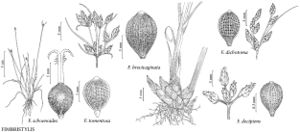Difference between revisions of "Fimbristylis decipiens"
Sida 4: 119, fig. 38. 1971.
imported>Volume Importer |
imported>Volume Importer |
||
| Line 53: | Line 53: | ||
|publication year=1971 | |publication year=1971 | ||
|special status=Illustrated;Endemic | |special status=Illustrated;Endemic | ||
| − | |source xml=https:// | + | |source xml=https://bitbucket.org/aafc-mbb/fna-data-curation/src/2e0870ddd59836b60bcf96646a41e87ea5a5943a/coarse_grained_fna_xml/V23/V23_193.xml |
|genus=Fimbristylis | |genus=Fimbristylis | ||
|species=Fimbristylis decipiens | |species=Fimbristylis decipiens | ||
Latest revision as of 21:39, 5 November 2020
Plants annual, cespitose, to 30 cm, base soft, not bulbous; rhizomes absent. Leaves nearly distichous, mostly spreading, to 2/3 length of culms; sheaths ciliate, sheath backs often pilose-hirsute; ligule present, complete; blades narrowly linear, 1.5–2.5 mm wide, flat or shallowly concave, margins scabrid, abaxial surface scattered-pilose, hirsute-ciliate at least proximally. Inflorescences: anthelae simple or compound, open, divaricately branched, mostly as broad as long; scapes slender, 1 mm wide, distally slightly compressed; proximalmost involucral bract exceeding or shorter than anthela. Spikelets pale brown or red-brown, ovoid to lanceoloid, 5–6 mm; fertile scales broadly ovate, 1.5–2 mm, acute- to obtuse-angled, midrib short-excurrent as mucro. Flowers: stamens 1–2; styles 2-fid, flat, fimbriate. Achenes whitened-iridescent to brown, lenticular or pyriform-obovoid, 1 mm, cancellate, each face with 5–12 vertical rows of transversely oriented rectangular pits, achene margins distally papillose. 2n = 20.
Phenology: Fruiting late summer–fall.
Habitat: Disturbed sites, low pinelands, banks, and fields
Elevation: 0–100 m
Distribution

Ala., Fla., Ga., La., Miss., N.C., S.C., Tex.
Discussion
In the Atlantic and Gulf Coastal plains, Fimbristylis decipiens often shares habitat with two close, likewise weedy, relatives: F. dichotoma and F. annua. From the former F. decipiens is distinguished by its annual habit, its papillose distal achene edges, and the more spreading anthela branches; from the latter it differs in its usually less papillose achene and its harder, more spreading foliage. No intergrades appear to occur among the three.
Selected References
None.
